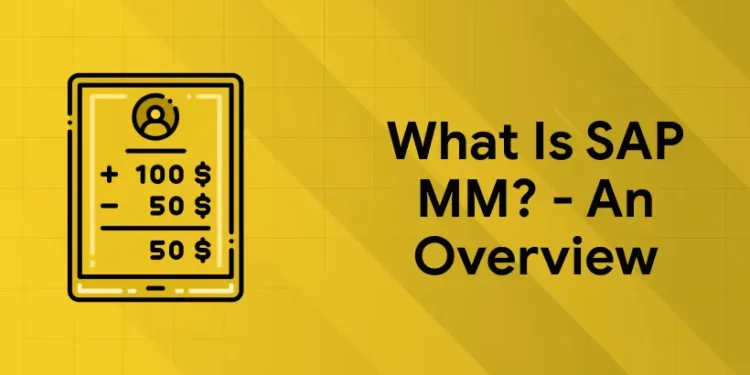Table of Contents
We’ll start this SAP MM blog article by learning about the SAP MM Module. A crucial component of the SAP ERP software is the SAP MM Module. Because SAP Material Management is time- and money-efficient, many businesses utilise it to manage their transactional data and purchasing. In this Article we will discuss different aspects of SAP MM Module.
What is SAP MM Module?
SAP MM (Material Management) Module is a SAP ERP component that assists organisations with material management, inventory management, and warehouse management throughout the supply chain process. It is a part of the logistical activities of SAP ECC, which are made up of a number of main and minor components. Purchasing, inventory, and master data are the three most important and frequently utilised components.
Every one of these components has a subcomponent that is necessary for a particular business process, and every single process is carried out through the use of transactions in the SAP MM process flow.
In SAP, a transaction is the processing of specific data to fulfil a business process requirement. If you buy ten litter buckets, for instance, you can use a specific transaction code (t-code) to make SAP reflect those modifications. The majority of business processes span one, two, or more modules and require the completion of numerous SAP transactions.
Join to learn SAP MM from the Experts! Click for the demo class!
Features of SAP MM
- SAP MM is one of SAP’s modules that deals with material and inventory management.
- The organization’s supply chain process is guaranteed to have no gaps or shortages of supplies thanks to the process of material management. SAP MM expedites the material management and procurement processes, ensuring that the business operates with total cost and time efficiency.
- In order to increase productivity and cut expenses, it deals with managing an organization’s resources and materials (products and/or services). Simultaneously, SAP MM is highly adaptable to the regular changes that occur in any business setting.
- It covers a number of topics, including inventory management, material need planning, account determination and material valuation, master data (material and vendor master), and procurement.
Where is the SAP MM Module Used?
The SAP MM module is a comprehensive component of the SAP ERP (Enterprise Resource Planning) system that oversees an organization’s whole procurement and materials management process. It includes many features, such as inventory control, logistics, and material planning and procurement. This is how SAP MM works:
Master Data Management
- Material Master Data: Descriptions, characteristics, units of measurement, and procurement specifics are all stored in material master records.
- Vendor Master Data: Information regarding suppliers, including as contact information, terms of payment, and delivery schedules, are kept in vendor master records.
- Information Records: Information records connect suppliers and materials by offering specifics regarding terms, conditions, and cost of purchase.
Procurement Process
- Purchase Requisition: An internal document used to seek the procurement of products or services.
- Request for Quotation (RFQ): A request for quotes for goods or services sent to suppliers.
- Purchase Order (PO): A formal document issued to a vendor that specifies the things to be purchased, quantities, delivery dates, and prices.
- Release Strategy: If set up, some purchase orders need to be approved by specific people or departments before they can be processed.
- Goods Receipt (GR): To update inventory and start payment procedures, a goods receipt is entered upon receipt of items.
- Verification of Invoices: To guarantee correctness, purchase orders and goods receipts are compared with the invoices obtained from suppliers. Conflicts are handled and settled.
Inventory Management
- Goods Issue: A goods issue transaction is made whenever resources are taken out of stock for use in manufacturing, consumption, or other activities.
- Stock Transfer: Stock transfer orders can be used to move materials between plants, storage facilities, or business codes.
- Reservation: To guarantee availability when required, materials might be set aside for particular uses (like manufacture).
- Physical Inventory: To guarantee accuracy, physical counts of inventory are conducted on a regular basis or on demand.
Materials Planning
Material Requirements Planning (MRP): MRP uses open purchase orders, sales orders, and current stock to determine future material requirements. In order to satisfy demand, it produces procurement bids.
Analytics and Reporting
To keep an eye on procurement, inventory levels, purchase history, vendor performance, and other pertinent indicators, SAP MM offers a variety of reports and analytics.
Integration
To provide smooth data flow across various business processes, SAP MM is connected with other SAP modules, such as Finance (FI), Sales and Distribution (SD), and Production Planning (PP).
Why Organizations use SAP MM?
SAP MM is used by organisations for a variety of purposes because it provides a wealth of advantages that improve their supply chain, materials management, and procurement procedures. These are some of the main justifications given by companies for using and implementing SAP MM.
Streamlined Procurement Process:
Complete procurement process support, from purchase requisition to payment, is offered by SAP MM. This guarantees consistent and effective procurement procedures while streamlining the procurement workflow and lowering manual labour.
Improved Inventory Management:
SAP MM gives businesses real-time information over the numbers, locations, and movements of their stocks, enabling them to optimise inventory levels. By reducing the possibility of stockouts and overstocking, this improves resource efficiency and lowers costs.
Enhanced Supplier Collaboration:
Organisations may track supplier performance, negotiate better terms, and maintain accurate vendor records with SAP MM’s vendor management tools. Strong supplier connections and cooperation are fostered by this.
Accurate Cost Tracking and Reporting:
Organisations can precisely track material, procurement, and inventory expenses with SAP MM. Cost analysis, planning, and financial reporting can all be done using this data.
Standardized Processes:
Standardised materials management and procurement procedures are enforced throughout the company by SAP MM. This lowers unpredictability, boosts process effectiveness, and strengthens adherence to both internal and external regulations.
Integration with Other SAP Modules:
Other SAP modules, including Finance (FI), Sales and Distribution (SD), and Production Planning (PP), are easily connected with SAP MM. Repetitive data entry is removed thanks to this integration, which also guarantees consistent data flow.
Efficient Materials Planning:
Based on sales orders, production schedules, and present inventory levels, companies can plan for future material requirements with the use of SAP MM’s Material Requirements Planning (MRP) feature. By doing this, the availability of materials for manufacturing or consumer orders is guaranteed.
Reduced Manual Work and Errors:
Automating procurement and inventory processes in SAP MM lowers the need for manual data entry, lowering the risk of errors and enhancing overall process accuracy.
ENTRI APP: SAP MM Course
Entri, a popular learning platform, provides a complete course on SAP S&P Sourcing and Procurement (MM- Material Management) to learners. The goal of our course is to provide students a thorough understanding of the SAP MM module, a crucial part of the SAP ERP system. Students will acquire knowledge about the different procedures related to material management, such as purchasing, inventory control, and invoice validation. In order to prepare students for job options, the course will also address topics including material requirement planning, vendor evaluation, and contract administration.
Conclusion:
To summarise, the SAP MM (Materials Management) module is a critical component of the SAP ERP (Enterprise Resource Planning) system, focusing on effective procurement, inventory management, and material planning operations. It is essential for optimising inventory levels, improving vendor collaboration, reducing the complexity of the entire supply chain, and guaranteeing the availability of supplies for manufacturing and delivery.
Join to learn SAP MM from the Experts! Click for the demo class!
Frequently Asked Questions
What is the role of SAP MM?
A SAP MM Functional consultant for improvements’ primary responsibility is to collaborate with business users to comprehend their needs, spot holes in the current system, and create and execute solutions to address those needs.
What is the difference between SAP MM and ERP?
ERP software aids in the management of business processes inside organisations. SAP is a global corporation that provides companies with ERP software solutions.
Is SAP MM easy to learn?
Yes, if you approach the material with the right attitude and readiness. The topic of SAP MM is quite wide. Takes at least thirty to forty hours to learn. The goal of the course is to simplify this procedure as much as is practical.
Can I learn SAP MM at home?
Yes, you can learn SAP MM at home via online classes, and Entri App offers the best SAP MM online training.










